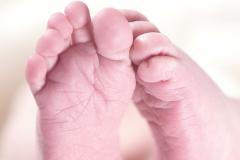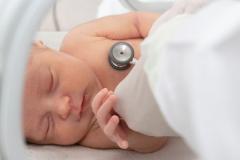- Overview
-
My research program aims at investigating how early-life stress (e.g. pain, inflammation, clinical treatments) affects the developing brain of very preterm infants, conducting pre-clinical and clinical research. I use an animal model that closely captures critical aspects of what preterm infants are like and what they may experience in the NICU. The use of preclinical models allows mechanistic studies on how exposure to early-life adversity alters the normal trajectory of brain development. This research, in turn, better informs clinical studies in preterm infants and the development of novel treatments to mitigate adverse effects from these exposures.
This work is motivated by my clinical nursing background as a paediatric clinical nurse specialist in acute pain, and builds upon my doctoral training in infant brain reactivity to pain (McGill University/Harvard University/Boston Children’s Hospital) and postdoctoral fellowship in pediatrics/neuroscience at UBC (2012-16), as well as my work as a research scientist at Columbia University in the division of Developmental Neuroscience (2017-18).
- Publications
-
The international Perinatal Outcomes in the Pandemic (iPOP) study: protocol [version 1; peer review: 2 approved]
Sarah J. Stock and Helga Zoega and Meredith Brockway and Rachel H. Mulholland and Jessica E. Miller and Jasper V. Been and Rachael Wood and Ishaya I. Abok and Belal Alshaikh and Adejumoke I. Ayede and Fabiana Bacchini and Zulfiqar A. Bhutta and Bronwyn K. Brew and Jeffrey Brook and Clara Calvert and Marsha Campbell-Yeo and Deborah Chan and James Chirombo and Kristin L. Connor and Mandy Daly and Kristjana Einarsdóttir and Ilaria Fantasia and Meredith Franklin and Abigail Fraser and Siri Eldevik Håberg and Lisa Hui and Luis Huicho and Maria C. Magnus and Andrew D. Morris and Livia Nagy-Bonnard and Natasha Nassar and Sylvester Dodzi Nyadanu and Dedeke Iyabode Olabisi and Kirsten R. Palmer and Lars Henning Pedersen and Gavin Pereira and Amy Racine-Poon and Manon Ranger and Tonia Rihs and Christoph Saner and Aziz Sheikh and Emma M. Swift and Lloyd Tooke and Marcelo L. Urquia and Clare Whitehead and Christopher Yilgwan and Natalie Rodriguez and David Burgner and Meghan B. Azad and iPOP Study
DOI: 10.12688/wellcomeopenres.16507.1
02/2021Adverse behavioral changes in adult mice following neonatal repeated exposure to pain and sucrose
Frontiers in Psychology
Ranger, M. and Tremblay, S. and Chau, C.M.Y. and Holsti, L. and Grunau, R.E. and Goldowitz, D.
DOI: 10.3389/fpsyg.2018.02394
2019Hippocampus, amygdala, and thalamus volumes in very preterm children at 8 years: Neonatal pain and genetic variation
Frontiers in Behavioral Neuroscience
Chau, C.M.Y. and Ranger, M. and Bichin, M. and Park, M.T.M. and Amaral, R.S.C. and Chakravarty, M. and Poskitt, K. and Synnes, A.R. and Miller, S.P. and Grunau, R.E.
DOI: 10.3389/fnbeh.2019.00051
2019Is near infrared spectroscopy valid for the detection of procedural pain in postoperative cardiac surgery intensive care unit adults?
Journal of Near Infrared Spectroscopy
Gélinas, C. and Boitor, M. and Ranger, M. and Johnston, C.C. and De Marchie, M. and Cervero, F. and Choinière, M.
DOI: 10.1177/0967033517730369
2017Repeated exposure to sucrose for procedural pain in mouse pups leads to long-term widespread brain alterations
Pain
Tremblay, S. and Ranger, M. and Chau, C.M.Y. and Ellegood, J. and Lerch, J.P. and Holsti, L. and Goldowitz, D. and Grunau, R.E.
DOI: 10.1097/j.pain.0000000000000961
2017Neonatal Invasive Procedures Predict Pain Intensity at School Age in Children Born Very Preterm
Clinical Journal of Pain
Valeri, B.O. and Ranger, M. and Chau, C.M.Y. and Cepeda, I.L. and Synnes, A. and Linhares, M.B.M. and Grunau, R.E.
DOI: 10.1097/AJP.0000000000000353
2016How do babies feel pain?
eLife
Ranger, M. and Grunau, R.E.
DOI: 10.7554/eLife.07552
2015Neonatal Pain and Infection Relate to Smaller Cerebellum in Very Preterm Children at School Age
Journal of Pediatrics
Ranger, M. and Zwicker, J.G. and Chau, C.M.Y. and Park, M.T.M. and Chakravarthy, M.M. and Poskitt, K. and Miller, S.P. and Bjornson, B.H. and Tam, E.W.Y. and Chau, V. and Synnes, A.R. and Grunau, R.E.
DOI: 10.1016/j.jpeds.2015.04.055
2015Early repetitive pain in preterm infants in relation to the developing brain
Pain management
Ranger, M. and Grunau, R.E.
DOI: 10.2217/pmt.13.61
2014Neonatal pain and comt Val158Met genotype in relation to serotonin transporter (SLC6A4) promoter methylation in very preterm children at school age
Frontiers in Behavioral Neuroscience
Chau, C.M.Y. and Ranger, M. and Sulistyoningrum, D. and Devlin, A.M. and Obertander, T.F. and Grunau, R.E.
DOI: 10.3389/fnbeh.2014.00409
2014Innovating in Pain Assessment of the Critically Ill: Exploring Cerebral Near-Infrared Spectroscopy as a Bedside Approach
Pain Management Nursing
Ranger, M. and Gélinas, C.
DOI: 10.1016/j.pmn.2012.03.005
2014Internalizing behaviours in school-age children born very preterm are predicted by neonatal pain and morphine exposure
European Journal of Pain (United Kingdom)
Ranger, M. and Synnes, A.R. and Vinall, J. and Grunau, R.E.
DOI: 10.1002/j.1532-2149.2013.00431.x
2014A multidimensional approach to pain assessment in critically ill infants during a painful procedure
Clinical Journal of Pain
Ranger, M. and Celeste Johnston, C. and Rennick, J.E. and Limperopoulos, C. and Heldt, T. and Du Plessis, A.J.
DOI: 10.1097/AJP.0b013e31826dfb13
2013Neonatal Pain-Related Stress Predicts Cortical Thickness at Age 7 Years in Children Born Very Preterm
PLoS ONE
Ranger, M. and Chau, C.M.Y. and Garg, A. and Woodward, T.S. and Beg, M.F. and Bjornson, B. and Poskitt, K. and Fitzpatrick, K. and Synnes, A.R. and Miller, S.P. and Grunau, R.E.
DOI: 10.1371/journal.pone.0076702
2013Maternal Touch and Talk for Invasive Procedures in Infants and Toddlers in the Pediatric Intensive Care Unit
Journal of Pediatric Nursing
Johnston, C.C. and Rennick, J.E. and Filion, F. and Campbell-Yeo, M. and Goulet, C. and Bell, L. and Tucci, M. and Ranger, M.
DOI: 10.1016/j.pedn.2010.12.016
2012Cerebral near-infrared spectroscopy as a measure of nociceptive evoked activity in critically ill infants
Pain Research and Management
Ranger, M. and Johnston, C.C. and Limperopoulos, C. and Rennick, J.E. and Du Plessis, A.J.
2011Incidence of self-limiting back pain in children following caudal blockade: An exploratory study
Paediatric Anaesthesia
Valois, T. and Otis, A. and Ranger, M. and Muir, J.G.
DOI: 10.1111/j.1460-9592.2010.03365.x
2010Toward a new approach for the detection of pain in adult patients undergoing cardiac surgery: Near-infrared spectroscopy—A pilot study
Heart and Lung: Journal of Acute and Critical Care
Gélinas, C. and Choinière, M. and Ranger, M. and Denault, A. and Deschamps, A. and Johnston, C.
DOI: 10.1016/j.hrtlng.2009.10.018
2010Interventions used in Emergency Departments (ED) for pain management of simple fractures in children
Cochrane Database of Systematic Reviews
Le May, S. and Fortin, C. and Johnston, C. and Choiniere, M. and Gouin, S. and Paquette, G. and Ranger, M.
DOI: 10.1002/14651858.CD007538
2009Developing synergy to enhance the impact of nursing intervention research on patient health
Canadian Journal of Nursing Research
Johnston, C. and Cossette, S. and Archer, J. and Ranger, M. and Nahas-Chebli, G.
2009Controlling bias in complex nursing intervention studies: A checklist
Canadian Journal of Nursing Research
Campbell-Yeo, M. and Ranger, M. and Johnston, C. and Fergusson, D.
2009An acute pain service improves postoperative pain management for children undergoing selective dorsal rhizotomy
Paediatric Anaesthesia
Frigon, C. and Loetwiriyakul, W. and Ranger, M. and Otis, A.
DOI: 10.1111/j.1460-9592.2009.03184.x
2009Temperament and Pain Response: A Review of the Literature
Pain Management Nursing
Ranger, M. and Campbell-Yeo, M.
DOI: 10.1016/j.pmn.2007.09.005
2008Theoretical, Psychometric, and Pragmatic Issues in Pain Measurement
Pain Management Nursing
Gélinas, C. and Loiselle, C.G. and LeMay, S. and Ranger, M. and Bouchard, E. and McCormack, D.
DOI: 10.1016/j.pmn.2007.12.001
2008Current Controversies Regarding Pain Assessment in Neonates
Seminars in Perinatology
Ranger, M. and Johnston, C.C. and Anand, K.J.S.
DOI: 10.1053/j.semperi.2007.07.003
2007Continuous axillary block for paediatric trauma patients who failed with PCA therapy
Acute Pain
Ranger, M. and Desparmet, J. and Goujard, E.
DOI: 10.1016/j.acpain.2006.09.001
2006Horner's syndrome following thoracic epidural analgesia in children: A report of two cases
Acute Pain
Valois, T. and Ranger, M. and Raghavendran, S.
DOI: 10.1016/j.acpain.2006.05.001
2006 - Research
-
The role of neuroinflammation in early life pain/sucrose-induced neurodevelopment impairments
Improving access to pediatric symptom management: Engaging and educating health care practitioners to improve lives for children with serious illness in Nepal
Creating a Calmer NICU: Pilot Testing a Robot for Optimizing Brain Development in Preterm Infants in the NICU
Brain-to-brain synchrony in mother-child and father-child dyads: a novel biomarker of brain development
GrantsHealthy Starts Catalyst grant (2021-2023)
Sheena Davidson Nursing Research Fund (2020-2022)
Research Group MembersSarah Coutts, Clinical trainee
Gael Hernandez Palmer, Capstone Student, Undergraduate Student, Worklearn Research Assistant
Mary Ibitoye, Graduate Trainee
Rujun Kang, Research Assistant/Lab Technician Level 4
Emily Schraeder, Master Student
Shawn Thai, Student volunteer
Reducing the impact of pain in the youngest children: Q&A with Dr. Manon Ranger
Dr. Manon Ranger is a new investigator at BC Children's Hospital and UBC studying new ways to reduce the impact of pain and early life stress on preterm babies.






